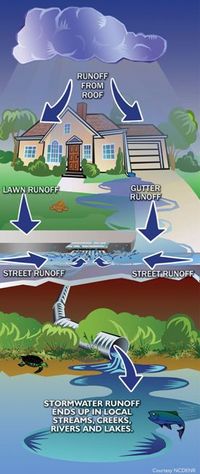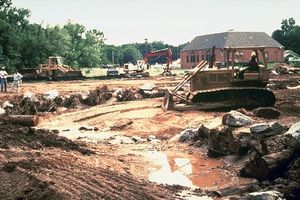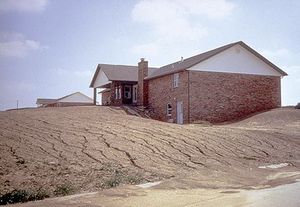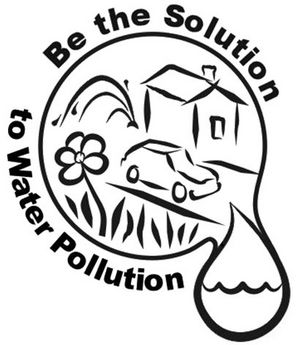Storm Water and Pollution Prevention


What is storm water?
Storm water is water from precipitation that flows across the ground and pavement when it rains or when snow and ice melt. The water seeps into the ground or drains into what we call storm sewers. These are the drains you see at street corners or at low points on the sides of your streets.
Collectively, the draining water is called storm water runoff and is a concern to us in commercial and industrial sites as well as your neighborhood because of the pollutants it carries.
Where does the storm water go after it drains into a storm drain?
Storm water that does not seep into the ground, drains into systems of underground pipes and may travel for a distance before being released into Springfield’s streams and wetlands.
Did you know that pollutants that enter storm drain inlets in the streets are not removed before entering our water resource areas?
Those substances that enter the storm drain system are not treated at all! Anything poured into a gutter or a storm drain, such as used motor oil or antifreeze, flows directly to our water resources.
What are common contributors to storm water pollution?
When it rains, oil, antifreeze, detergents, pesticides and other pollutants get washed from driveways, backyards, parking lots, businesses, construction sites, industrial plants and streets into storm drains and then directly to our streams and wetlands untreated!
The wastes, residues, and by-products from various activities enter storm drains with storm water runoff and flow into streams, creeks, and tributaries, harming fish and other aquatic life.
WHAT IS STORM WATER POLLUTION ?
Introduction
Storm water from urban runoff and sewers is one of the leading causes of pollution in rivers and lakes. In fields and forests, most rain is absorbed by the soil or is taken up by plants and trees. However, developed areas contain many impermeable surfaces like roofs, parking lots and streets. In developed areas, rainwater often travels over paved areas, settles in gutters and ditches, and flows through concrete storm drains. Rainwater that flows overland is called storm water or storm water runoff.
Storm water can quickly become polluted by chemicals, fertilizers, pesticides, and litter it picks up while traveling overland. Even small amounts of pollutants that accumulate on roads, parking lots, and sidewalks are quickly transported into nearby streams and rivers, causing major water quality problems. Identifying sources of storm water pollution and keeping them off the ground (away from storm drains or roadside ditches) is the best and most economical way to keep storm water clean.
The purpose of this fact sheet is to describe the significance of storm water pollution, its effects, and ways to reduce this water quality problem. The fact sheet discusses common storm water pollutants, activities that pollute storm water and ways to prevent storm water pollution.
Common Storm Water Pollutants
Common storm water pollutants are:
- Oil and grease - Oil from vehicles storage tanks and machinery, and grease from kitchen waste and engine lubricants can be carried by storm water into streams. Oil and grease float on the water's surface and block sunlight needed by underwater fish and plants. Oil and grease can also damage stream habitat and sensitive spawning areas when they cling to sand and gravel particles that settle to the bottom of streambeds.
- Heavy metals - Heavy metals like lead, zinc, and mercury, are ingredients in many commonly used products like batteries, fuels, paints, pesticides, and cleaners (e.g. algaecides). They can also be found in industrial-strength materials like rubber. When these products are spilled or improperly disposed of and when materials containing heavy metals break down, they leave behind pollutants that can be readily transported into streams by storm water. Heavy metals can be toxic to fish and other aquatic life in streams.
- Nutrients - Nutrients like phosphorus and nitrogen are transported into streams when storm water picks up fertilizer and animal manure residues on the ground. When excessive amounts of nutrients end up in water bodies, they accelerate algae growth and cause eutrophication, which disrupts life in ponds and streams.
- Chemicals - Toxic chemicals in fuels, paints, cleaning products, and pesticides (used at work and home) can harm not only users but also water quality and aquatic life when they are improperly handled. Chemicals, especially organic chemicals, have a wide range of toxic effects on fish and aquatic life, including causing tumors and skin lesions and disrupting reproductive functions.

- Mud and sediment - These are readily carried by storm and flood waters, causing excessive buildup (commonly called sedimentation). When storm water flows across construction sites and unplanted fields, it picks up loose dirt, creating mud, which is quickly carried into streams where it causes sedimentation pollution.
When too much sediment accumulates on streambeds, it damages fish-spawning areas, alters habitat where bottom-dwelling organisms live and reproduce, and interferes with fish migration. In addition, dirt and sand often pick up oil and grease in their path, which introduces additional chemical contaminants that are toxic to fish and other aquatic organisms.
- Litter - Debris that overflows from trash cans and litter thrown onto the ground are readily carried by storm water into streams and rivers where they harm fish and aquatic life, hinder sunlight penetration, and interfere with fish movement and migration.
- Abnormal pH - When storm water mixes with chemicals or chemical products that are acidic or alkaline, the pH of the water is changed. When acid rain and other forms of acid precipitation collect in streams and ponds, it also alters the pH. Acidic or alkaline conditions in streams harms fish, especially sensitive juvenile fish and other organisms.
- Coliform bacteria, - At high levels, naturally occurring coliform bacteria from human and animal wastes can contaminate water. Picking up and disposing of pet feces helps prevent bacteria pollution and eutrophication in streams.
Activities That Pollute Storm Water
Leading sources of storm water pollution are:
- Refueling, engine repair, equipment washing, and painting activities, especially when these activities occur outdoors or when wastewater is released outside.
- Roads, parking lots, and other paved surfaces where fluids have leaked, hazardous materials have spilled, or litter, particles, and sediments have accumulated.
- Outdoor vehicle, equipment, and material storage that exposes spilled, leaked, and overflowing fluids and chemicals to rain and storm water runoff.

- Outdoor cleaning and maintenance activities like power washing, sandblasting, and car washing that produce large volumes of wastewater.
- Construction activities that excavate land, exposing loose dirt and sand.
- Commercial and municipal properties and residential lawns where fertilizers and pesticides are used.
- Landfills, trash storage areas, and waste handling and disposal activities when improperly managed.
Wastes, residues, and by-products from these activities enter storm drains and flow into streams, creeks, and tributaries, harming fish and other aquatic life.
Indicators of Storm Water Pollution
The following are indicators of storm water pollution:
- An oil sheen on the water's surface
- Roads, parking lots, and other paved surfaces where fluids have leaked, hazardous materials have spilled, or litter, particles, and sediments have accumulated.
- Stains on and around the ground and storm drains
- Unusual discoloration of grass, plants, and vegetation
- Distressed vegetation and plants
- Poorly maintained, corroded, or damaged drums and machinery
- Commercial properties and residential lawns where fertilizers and pesticides are used.
- Uncovered and improperly maintained storage areas and dumpsters
Wastes, residues, and by-products from these activities enter storm drains and flow into streams, creeks, and tributaries, harming fish and other aquatic life.

Preventing Storm Water Pollution
There are both simple and complex ways to prevent and control storm water pollution. Individual efforts, like those below, may seem trivial but collectively add up to considerable storm water pollution prevention.
- Dispose of litter properly.
- Keep storm drains clear of debris, dirt, sand, silt, and wastes.
- Catch fluids and recycle or properly dispose of them when changing car oils, antifreeze, and other fluids. Participate in the facility's oil recycling program.
- Wash cars or other greasy equipment at facilities, such as commercial car washes, that collect wastewater and discharge it into a sanitary sewer where detergent and oily pollutants can be removed at sewage treatment plants.
- Reduce or eliminate chemical pesticides and fertilizers for landscaping and lawns.
- Plant around or pave areas prone to erosion to reduce the chance that loose dirt, soil, and sand will be carried away by storm water runoff.